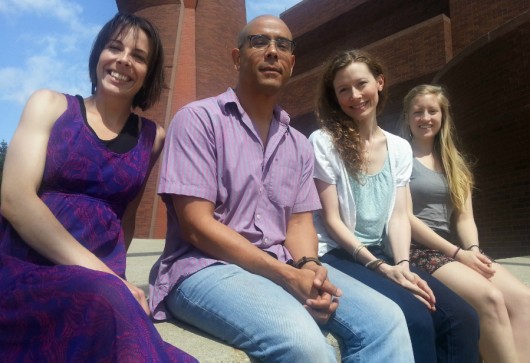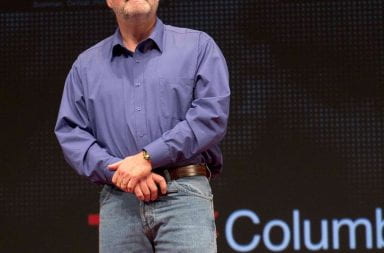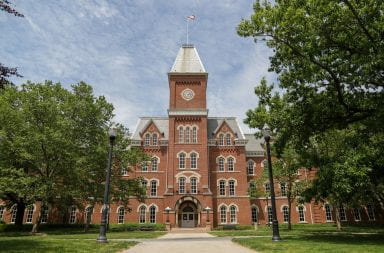
Ohio State researchers have turned to a crowdfunding website in an effort to help raise funding for the continuation of their research. From left to right: Nicole Garlando, Maurice Stevens, Tracie McCambridge and Michelle Hablitzel sit outside the Wexner Center for the Arts. Credit: Michael Huson / Campus Editor
When Ohio State researchers began investigating how contemporary art and Brazilian jiujitsu affect individuals living with brain injury, they were exploring changes in the participants’ quality of life, brain function and community engagement.
But as researchers approached the end of their initially planned 18-week study, they discovered something new: the participants didn’t want the study to stop. And the researchers are now exploring ways to fund its continuation.
Principal investigators Maurice Stevens, an associate professor in comparative studies, and Tracie McCambridge, educator for docent and teacher programs at the Wexner Center for the Arts, have turned to a crowdfunding website for researchers called Experiment.com.
Experiment.com contacted OSU looking for interested researchers at a time when Stevens said there have been decreases in funding from some national research funding agencies.
“I think OSU is interested in this, and probably other institutions are going to be interested in it, because funding is drying up all over the place,” he said. “For OSU, this is about trying out some other way to have an income stream that’s not dependent on these big institutions.”
The project, “Recuperating the Social Brain,” which began last February, was originally funded through a $19,000 grant.
The interdisciplinary team hopes to continue their research by posing a question, which also serves as the title of their crowdfunding campaign, “Can art interpretation, jiu jitsu, meditation and service heal brain injury?”
Fundraising through Experiment.com holds several benefits, such as an online platform to reach a diverse range of people outside academia and keeping backers updated throughout the research with access to online lab notes.
But there is a catch: Experiment.com crowdfunding campaigns are all-or-nothing; fundraisers either reach their targeted amount and keep their funding, or they fall short of their goal and lose everything.
The funding campaign has reached a little more than 50 percent of its $3,665 pledge goal, and their last day to collect pledges is June 22.
The research team hopes to continue investigating how individuals recovering from brain or mind injuries are effected by engaging in activities like jiujitsu, art interpretation, meditation, yoga and community service learning.
“I think there’s a common thread in that each of those practices involve people coming to an understanding of themselves as having agency and control of themselves and their experience,” Stevens said.
The group of research participants, which includes individuals recovering from concussive injury, stroke, brain surgery and post-traumatic stress disorder, are paired with a caregiver or loved one who shares in the experience and engagement of each activity.
“We’re recognizing injury as very complex and something that ripples out to an entire system surrounding the person,” McCambridge said.
Stevens said the research and nontraditional treatment approaches aims to improve participants’ quality of life and brain function, as well as help foster community engagement by connecting participants to the larger community and to each other.
“We’re really interested in having the experience be what’s new, what’s at the center, and not the diagnosis,” Stevens said. “(Participants) are changing the meaning of their experience as they go through this program, within their system, and in that way, the meaning of the injury changes.”
After recovering from the acute phase of an injury, patients are often given recovery benchmarks and goals based on that individual’s state prior to the injury, Stevens said, adding that this research offers a different perspective.
“For me, the major shift is that we’re just saying, ‘Where are we now? How are you living now?’ Rather than focusing on ‘this is how you’re broken and this is where you’re supposed to get to,’ what we’re seeing is people discovering what they have, what they are,” Stevens said.
One participant was able to rediscover his lost knowledge of tai chi, which he hadn’t performed in more than 30 years, after participating in jiujitsu sessions during research, said Stevens.
“Now, he’s engaging in this old practice that is restorative for him,” Stevens said. “He got to discover a capacity that he didn’t realize he had.”
McCambridge, who created the Wexner Center for the Arts program Art on the Brain, said she observed participants forming friendships and increasing their engagement with the group during art interpretation sessions.
Participants also engaged in a community service learning aspect of the research through collaboration with the Columbus Growing Collective, a group that promotes agricultural initiatives in the Columbus area.
Michelle Hablitzel, a fifth-year in international studies and geography, said she volunteered with the group to help organize and plant an urban farm and garden in the Milo-Grogan neighborhood, east of the Short North, adding that she felt the group’s sense of involvement and engagement grew as their relationships strengthened.
“I felt like I was participating in it just as much as the actual participants, so it was a lot of fun,” she said.
Stevens said that so far, one obstacle the research team has encountered is the fixed, conventional perspective of evidence-based research design that exists in some fields, which can make attempting innovative or different research methods difficult.
“One potential contribution here is that it is another piece of evidence or data about how things can be done differently and that these things should be supported financially,” Stevens said.


